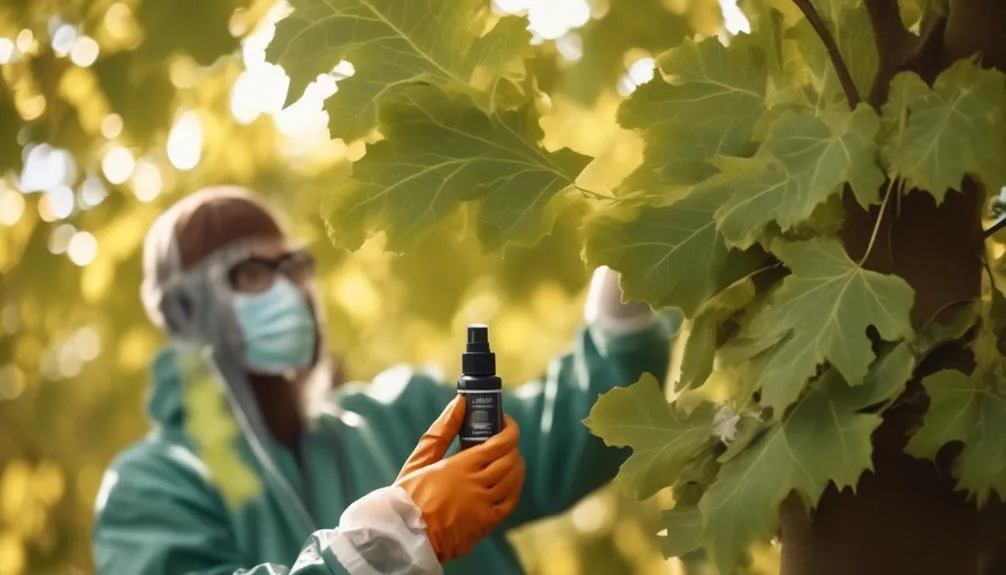Dealing with sycamore tree diseases like anthracnose, powdery mildew, or canker can be a common struggle for many. Recognizing the signs of these ailments is crucial for keeping your sycamore trees healthy.
Luckily, there are natural ways to fight these diseases without using harsh chemicals. By using natural pest control, organic fungicides, and proper pruning techniques, you can maintain the well-being of your sycamore trees in an eco-friendly manner.
Identifying Sycamore Tree Diseases
To identify sycamore tree diseases, carefully examine the leaves, bark, and overall health of the tree for any signs of discoloration, lesions, or abnormal growth. Prevention is key, so keep an eye out for early symptoms.
Look for any unusual spots or blotches on the leaves, which could indicate a fungal infection. Check for powdery mildew, a common issue that looks like a white powdery substance on the leaves.
Inspect the bark for any signs of cankers, which appear as sunken, damaged areas. These can indicate a bacterial or fungal infection.
Also, keep an eye out for any abnormal growth patterns, such as stunted or distorted leaves.
Implementing Organic Pest Control
As you examine the leaves and bark of your sycamore tree for signs of disease, you can effectively manage these issues by implementing organic pest control methods. Utilizing natural predators and companion planting are two excellent ways to keep pests at bay without the use of harmful chemicals. Natural predators such as ladybugs, lacewings, and birds can help control aphids, mites, and other common sycamore tree pests. Additionally, companion planting with insect-repelling plants like marigolds, chives, or garlic can deter pests from attacking your sycamore tree. Consider planting these companion plants around the base of your tree to create a natural barrier against harmful insects. By incorporating these organic pest control methods, you can promote a healthy and thriving sycamore tree without the need for synthetic pesticides.
| Organic Pest Control Methods | Description |
|---|---|
| Natural Predators | Introduce beneficial insects or attract birds to control pest populations. |
| Companion Planting | Plant insect-repelling species near your sycamore tree to deter pests. |
Using Natural Fungicides
Consider treating sycamore tree diseases organically by using natural fungicides to effectively manage fungal issues without resorting to synthetic chemicals.
Natural remedies like neem oil, garlic spray, or copper fungicides can help combat fungal infections on sycamore trees.
Neem oil, derived from the seeds of the neem tree, acts as a natural fungicide and can also deter pests.
Garlic spray, made from garlic bulbs and water, has antifungal properties that can help prevent and control fungal diseases.
Copper fungicides, while being naturally occurring, are effective in managing various tree diseases.
These organic treatments not only help in managing tree diseases but also promote environmental sustainability.
When using natural fungicides, ensure to follow the application instructions carefully for optimal results and minimal impact on the surrounding ecosystem.
Pruning and Sanitizing Practices
Prune and sanitize your sycamore trees regularly to maintain their health and prevent the spread of diseases. Follow these essential practices to ensure the well-being of your trees:
- Proper Pruning Techniques: Remove dead, damaged, or diseased branches to improve air circulation and sunlight penetration within the canopy. This helps prevent the development and spread of fungal infections and bacterial diseases.
- Sanitizing Tools: Disinfect pruning tools with a solution of 70% rubbing alcohol or 10% bleach to prevent the transmission of diseases from one tree to another.
- Remove and Destroy Infected Material: Promptly dispose of pruned branches and leaves from around the tree to prevent the buildup of disease-causing pathogens.
Maintaining Tree Health Through Organic Methods
To further enhance the health of your sycamore trees, implementing organic methods can effectively bolster their resilience against diseases and promote their overall well-being. Start by focusing on soil nutrition.
Ensure your trees are planted in well-draining soil rich in organic matter. Amend the soil with compost to provide essential nutrients and improve its structure. This fosters strong root development, making the trees more resistant to diseases. Additionally, consider using natural fertilizers like compost tea or seaweed extracts to nourish the soil and support tree health.
In terms of disease resistance, promoting a diverse ecosystem around your sycamore trees can help naturally control pests and diseases. Introducing companion plants that attract beneficial insects or implementing integrated pest management techniques can reduce the risk of disease without the need for synthetic chemicals.
Conclusion
By embracing organic pest control, natural fungicides, and diligent tree maintenance, you can safeguard your sycamore trees from diseases while nurturing a sustainable environment.
Your efforts contribute to the well-being of your trees and the larger ecosystem.
Keep tending to your sycamore trees with care and commitment.

My interest in trees started when I first saw the giant sequoias in Yosemite.
I was a teenager then, and I remember thinking, “I need to learn more about this.”
That moment stuck with me.
A few years later, I went on to study forestry at Michigan Tech.
Since graduating, I’ve worked in a mix of hands-on tree care and community education.
I’ve spent over ten years helping people understand how to plant, maintain, and protect the trees in their neighborhoods.
I don’t see trees as just part of the landscape.
They are living things that make a real difference in our daily lives.
